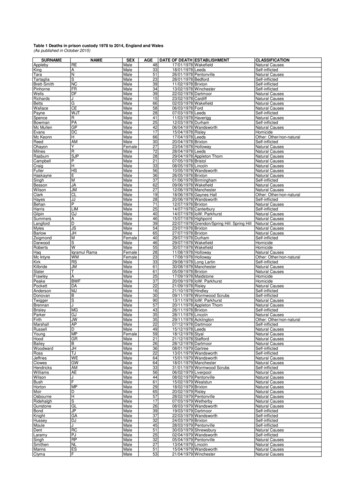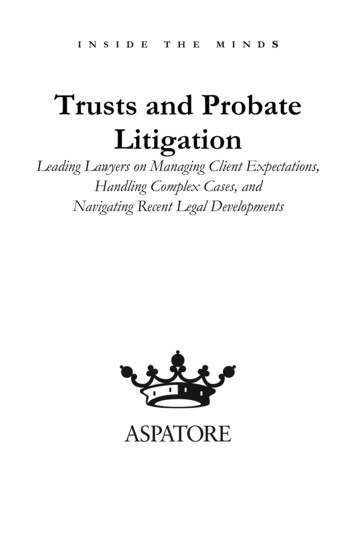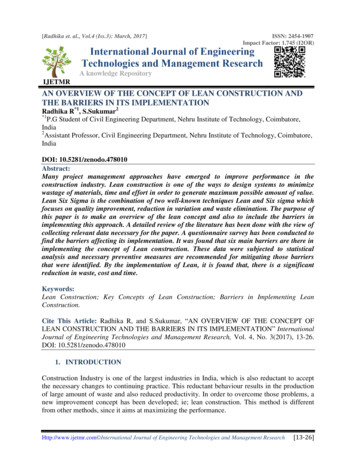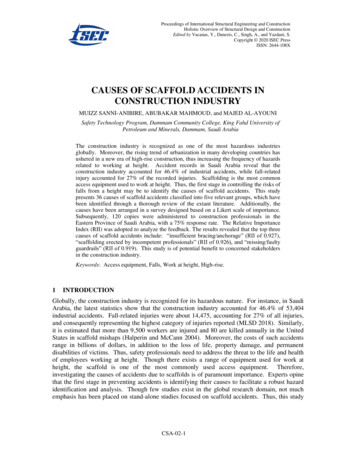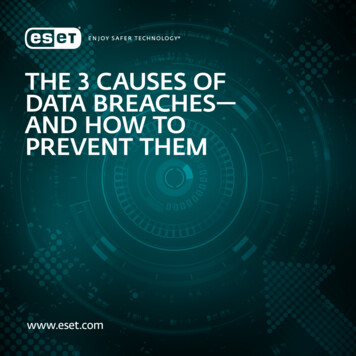
Transcription
THE 3 CAUSES OFDATA BREACHES—AND HOW TOPREVENT THEMwww.eset.com
The 3 causes of data breaches—and how to prevent themBy Ben Reed, Sr. Technical Content Strategist and Sales EngineerSecurity breaches have become a weekly occurrence in the news cycle,which has caused businesses to start asking questions. How are theyhappening? Is my business at risk?The short answer is yes, your business is at risk. Here’s an overview on howdata breaches occur, why they’re on the rise, and what steps to take nowto protect your business.Data breaches can be broken down into three separate categories: IT andbusiness process failures, human error and malicious attacks, according tothe Ponemon Institute.IT and business process failures accounted for 27 percent of the incidents in2016. These kinds of breaches occur when a company purchases a securitysolution such as antivirus software or encryption, but doesn’t keep itupdated or enforce related security policies over the years. They also occurwhen a company purchases a security product but never implements it.23
Human error, which can include someone leaving a computer unlocked,writing a password on a sticky note, or losing a device, accounted for 25percent of breaches. Interestingly, 73 percent of devices that were lost orstolen were in the owner’s work area or car (Verizon Data BreachReport 2016).The final category, malicious attacks, is what most people think of whenthey hear about “hacking” in the news. However, actual hacking is a verysmall subset of total malicious breaches at just 22 percent. (Most hackersgain access to computers by simply guessing weak or default passwords, orby stealing them.)The majority (60 percent) of malicious breaches is attributable to malware,such as viruses, with the remaining breaches (18 percent) caused bysocial engineering.45
Malware is becoming more of a problem, as the number of malware strainstypically doubles every 12 to 16 months. Currently, the independent testingfacility AV-Test sees around 390,000 new malicious items per day. Also,malware is no longer Windows specific—it also targets Mac and Linuxwith programs developed specifically to attack these operating systems.Because Mac and Linux users tend not to have any antivirus protection,when malware is written for these platforms it has a very high penetrationand infection rate.The final type of malicious breach is social engineering, which tends to bea person calling or emailing and pretending to be someone else. The mostcommon form of social engineering is phishing emails. The endgame ofthese social engineering attempts is to “fish” for information that can beutilized to log into your accounts. Some questions may seem innocuous,such as what is your pet’s name or the street you grew up on, but theseare the answers to the most commonly used security questions needed toreset your passwords.Ask a typical computer user and he or she will claim that they never clickon links in email, they never respond to emails from people they do notknow, and they always do the right things when it comes to online security.However, the statistics don’t lie: they show that 30 percent of people open67
phishing emails, and 12 percent of people open attachments (Verizon 2016Data Breach Investigations Report). Obviously, more education is requiredaround this topic to protect your company from this ever-growing threat.So: how to protect your business, computers and data from these differentthreat vectors? Here are some basics. Overall, your best bet is to implementa multilayered security strategy that can prevent, detect and eradicatethreats as well as protecting your data, systems and users.Malicious attacksImplement endpoint security solutions that will protect against viruses,ransomware and other types of malware. For added security andconvenience, look for a solution with cross-platform capability that canbe easily managed. ESET’s award-winning endpoint threat protectionprovides comprehensive security that can be managed from a singleconsole with ESET Remote Administrator.HackingProtect against weak or shared passwords with two-factor authentication(2FA). ESET Secure Authentication offers easy-to-implement 2FA, which canprotect local desktop logins, remote desktops, VPNs and devices.8Social engineeringESET Mail Security ties directly into your exchange server and protects usersfrom phishing schemes and spam emails. Using a cloud provider? ESETEndpoint Security products provide the same level of protection at the emailclient level, and also feature web access protection to prevent users fromvisiting potentially harmful websites.Lost devicesOne of the smartest security moves you can make is to encrypt computers,flash drives and emails so that your data is protected from unauthorizedusers. DESlock Data Encryption will help ensure that your data isinaccessible, even if a flash drive or mobile device is lost or stolen.IT issues and process failureWhat would you do if a natural disaster or power failure crashed yourcomputers? Be sure to have a backup and recovery system in place, suchas StorageCraft, that can quickly restore your data, apps and systems. Andmake sure the security software you choose comes with good customersupport. ESET provides free, U.S.-based tech support to help keep yourunning smoothly 24/7.9
With 10 years of experience in both small and large organizations,Ben Reed has quickly grown through the IT ranks. He has held severaldifferent positions in IT including help desk, system administrator andsolutions engineer.Ben has been at ESET for over three years and has immersed himself in theESET Remote Administrator and ESET Endpoint Clients, helping customerswith configuration and deployment of ESET solutions.For over 25 years, ESET has been developing industry-leading security softwarefor businesses and consumers worldwide. With security solutions ranging fromendpoint and mobile defense to encryption and two-factor authentication, ESET’shigh-performing, easy-to-use products give users and businesses the peace ofmind to enjoy the full potential of their technology. ESET unobtrusively protectsand monitors 24/7, updating defenses in real time to keep users safe and businessesrunning uninterrupted. For more information, visit www.eset.com. 1999-2016 ESET, LLC, d/b/a ESET North America. All rights reserved.ESET, the ESET Logo, ESET SMART SECURITY, ESET CYBER SECURITY, ESET.COM,ESET.EU, NOD32, SysInspector, ThreatSense, ThreatSense.Net, LiveGrid and LiveGridlogo are trademarks, service marks and/or registered trademarks of ESET, LLC, d/b/aESET North America and/or ESET, spol. s r.o., in the United States and certain otherjurisdictions. All other trademarks and service marks that appear in these pagesare the property of their respective owners and are used solely to refer to thosecompanies’ goods and services.1011
stolen were in the owner's work area or car (Verizon Data Breach Report 2016). The final category, malicious attacks, is what most people think of when they hear about "hacking" in the news. However, actual hacking is a very small subset of total malicious breaches at just 22 percent. (Most hackers



